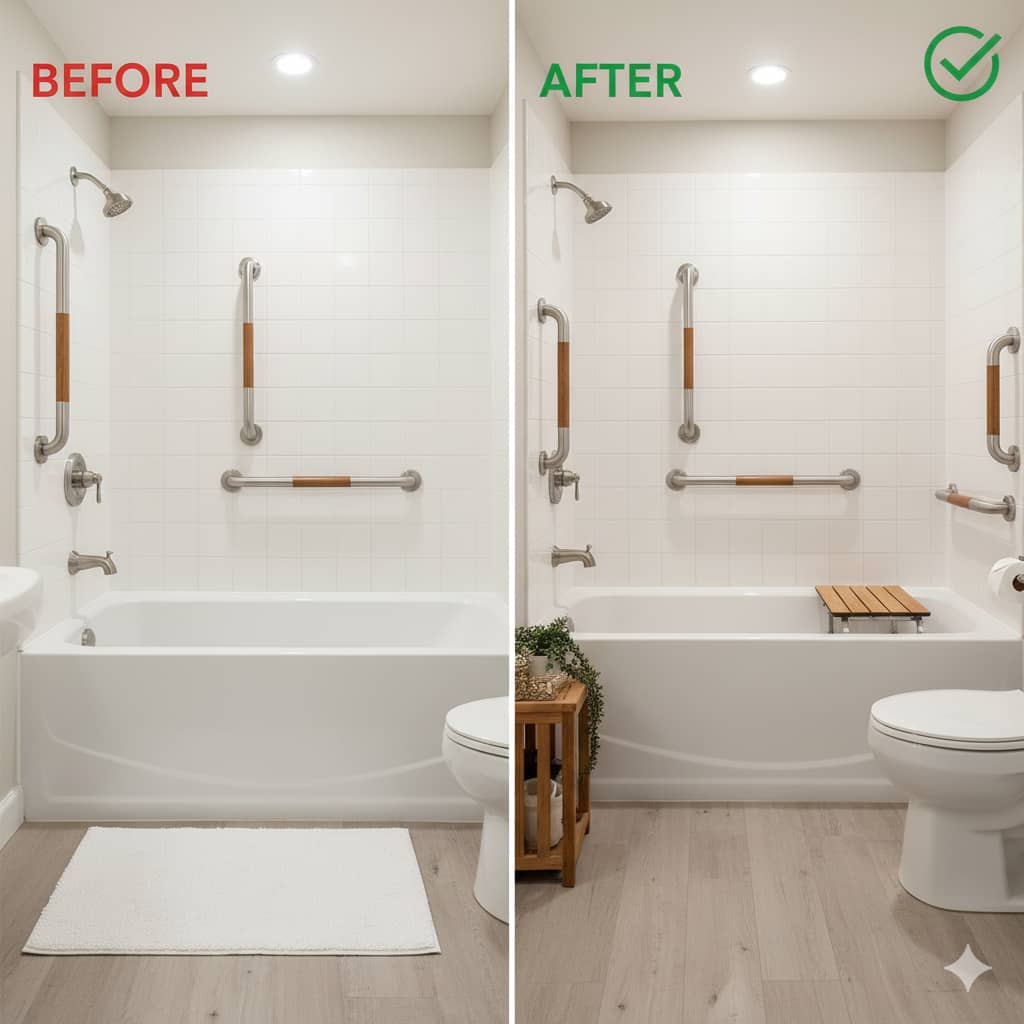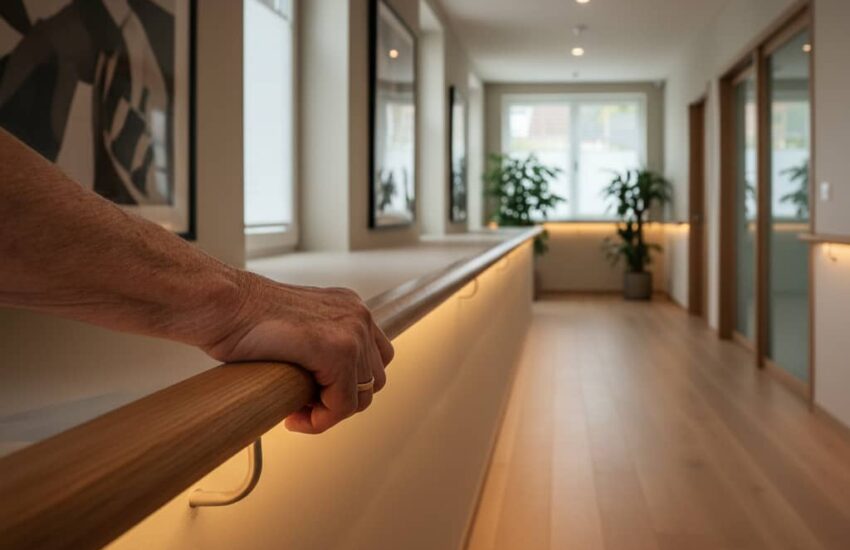Handrails do more than prevent falls, they preserve independence and confidence. Discover how proper railing installation and placement can significantly reduce senior injury risks. There’s a particular sound I’ve come to recognize in homes where seniors live without adequate handrails—the faint shuffle of feet moving cautiously across uncarpeted floors, the hesitant pause before navigating a single step, the white-knuckled grip on whatever furniture happens to be within reach. I first noticed this pattern while visiting my grandmother after her hip replacement. She’d developed what she called her “wall-walking” technique, pressing her palm against the hallway wall for support rather than admitting she needed what she considered “an old person’s crutch.” It wasn’t until she slipped while reaching for a light switch that we understood how something as simple as a properly installed handrail could mean the difference between independence and injury.
Handrails serve as continuous support systems that do more than prevent falls, they restore confidence in mobility. For seniors experiencing balance issues, weakened muscles, or visual impairment, having something stable to touch every few feet can transform fear-filled spaces into navigable territory. The psychological impact often outweighs the physical benefit: knowing support is always within reach allows seniors to move more freely, maintaining strength through activity rather than weakening through avoidance.
The science behind handrail effectiveness reveals why they’re more crucial than many realize. Studies show that properly installed handrails can reduce fall risk by up to 60% in critical areas like staircases and bathrooms. What makes this statistic remarkable is that falls represent the leading cause of fatal and non-fatal injuries among older adults, with hip fractures alone costing the healthcare system over $20 billion annually. Handrails aren’t just convenience features—they’re primary prevention tools that can literally save lives while reducing healthcare costs.
Strategic placement matters more than simply having rails present. The most effective installations create what occupational therapists call “continuous support pathways”—unbroken handrail systems that guide seniors from bedroom to bathroom, through hallways, and into living spaces without gaps in assistance. I’ve watched residents in well-designed facilities move confidently because they know they’ll never be more than an arm’s length from support, while those in poorly planned spaces develop anxiety about simple movements between rooms.
Height and diameter specifications make surprising differences in effectiveness. Standard building codes often specify 34-38 inches from the floor, but individual needs vary based on height, mobility, and strength. Too-low rails force stooping that compromises balance; too-high rails require reaching that strains shoulders. The ideal diameter, typically 1.5 to 2 inches—allows comfortable gripping without requiring excessive hand strength. Customizing these measurements to the individual user can transform a generic safety feature into personalized support.

Material selection impacts both safety and willingness to use handrails. Cold metal rails may discourage touch, especially for those with arthritis, while warmer materials like wood or vinyl-covered rails feel more inviting. Textured surfaces provide better grip than smooth finishes, particularly important for hands with reduced sensation or moisture from lotions. The best designs consider both tactile feedback and aesthetic appeal—handrails that blend beautifully with decor are more likely to be accepted than clinical-looking additions.
Bathrooms demand particular attention, as they present the highest fall risk areas in any home. Strategically placed grab bars near toilets, showers, and tubs provide stability during transitions that challenge balance. The most effective installations combine vertical and horizontal orientations to support both standing up and steadying while moving. I’ve seen simple $50 grab bar installations prevent injuries that could have resulted in $50,000 hospital stays, a stunning return on investment in both financial and human terms.
Stairway handrails require special consideration beyond single-level installations. They should extend beyond the top and bottom steps to provide support before stepping onto or off of stairs, a critical detail often overlooked in residential construction. Dual rails on both sides of staircases benefit those who need bilateral support or who may have stronger limbs on one side due to stroke or injury. These extensions create stability during the most dangerous moments of stair navigation.
Lighting integration enhances handrail effectiveness dramatically. Motion-activated LED strips installed beneath rails illuminate pathways without glare, helping seniors with diminished vision navigate safely during nighttime bathroom trips. This combination addresses two major fall risks simultaneously, poor lighting and lack of support—while being far more discreet than overhead lights that disrupt sleep patterns.
The social stigma associated with “looking disabled” often prevents handrail installation until after accidents occur. Reframing these supports as proactive wellness tools rather than disability aids increases acceptance. I’ve found success describing them as “balance assistants” or “confidence rails”—language that emphasizes empowerment rather than limitation. In communal settings, making handrails standard throughout a facility eliminates the stigma that might exist when they’re added to individual units.
Maintenance represents another overlooked aspect of handrail safety. Loose fasteners, splintering wood, or corroded mounts can create hazards rather than preventing them. Regular inspection protocols should check for stability, surface integrity, and secure mounting—particularly important in humid environments like bathrooms where hardware may deteriorate faster.
The return on investment for handrail installation defies conventional metrics. While dollar amounts can be calculated for prevented medical costs, the true value lies in preserved independence, maintained mobility, and reduced fear. For every dollar spent on proper handrails, families and facilities potentially save thousands in emergency care while providing something priceless: the confidence to move freely through one’s environment.
Perhaps the most compelling case for handrails comes from observing the subtle transformation in movement patterns after their installation. The hesitant shuffle becomes a confident stride. The white-knuckled grip on furniture relaxes. The avoidance of certain rooms gives way to renewed engagement with entire living spaces. In these small but significant changes, we see handrails fulfilling their highest purpose: not just preventing falls, but enabling lives.
References
AllSeniors.org. (2024, August 24). Benefits of using safety rails. https://allseniors.org/articles/benefits-of-using-safety-rails/
Irish Iron. (2023, June 25). The role of rod iron railings in preventing elderly falls. https://irishiron.com/blog/the-role-of-rod-iron-railings-in-preventing-elderly-falls/
New Lifestyles. (2024, July 22). Elderly safety: The importance of handrails. https://www.newlifestyles.com/blog/elderly-safety-the-importance-of-handrails
EZ Living Concepts. (2025, January 20). The importance of handrails for stairs: Ensuring safety at home. https://ezlivingconcepts.com/importance-of-handrails-for-stairs/
Phetsitong, R. (2022). Reducing the physical burden of older persons by providing household handrails. *International Journal of Environmental Research and Public Health*, 19(4), Article 2235. https://pmc.ncbi.nlm.nih.gov/articles/PMC8872235/

